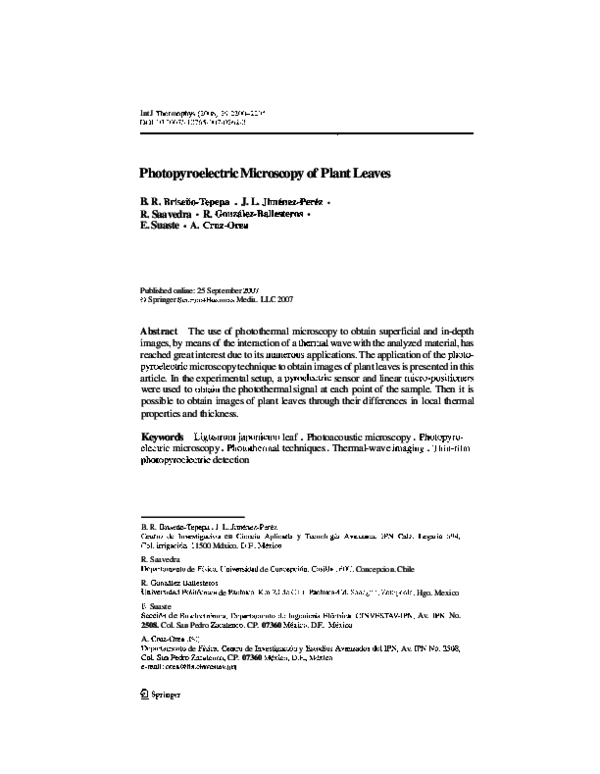Academia.edu no longer supports Internet Explorer.
To browse Academia.edu and the wider internet faster and more securely, please take a few seconds to upgrade your browser.
Photopyroelectric Microscopy of Plant Leaves
Photopyroelectric Microscopy of Plant Leaves
2008, International Journal of Thermophysics
The use of photothermal microscopy to obtain superficial and in-depth images, by means of the interaction of a thermal wave with the analyzed material, has reached great interest due to its numerous applications. The application of the photopyroelectric microscopy technique to obtain images of plant leaves is presented in this article. In the experimental setup, a pyroelectric sensor and linear micro-positioners were used to obtain the photothermal signal at each point of the sample. Then it is possible to obtain images of plant leaves through their differences in local thermal properties and thickness.
Related Papers
2014 •
Journal of Applied Physics
Photopyroelectric spectroscopy and calorimetryIn this Tutorial, we present an overview of the development of the photopyroelectric (PPE) technique from its beginning in 1984 to the present day. The Tutorial is organized into five sections, which explore both theoretical and experimental aspects of PPE detection as well as some important spectroscopic and calorimetric applications. In the “Introduction” section, we present the fundamental basics of photothermal phenomena and the state-of-the-art of photopyroelectric technique. In the “Theoretical aspects” section, we describe some specific cases of experimental interest, with examples in both back and front detection configurations. Several mathematical expressions for the PPE signal in specific detection modes (combined back–front configurations and PPE–thermography methods) are also deduced. The “Instrumentation and experiment” section contains two subsections. The first describes several examples of setups used for both room temperature and temperature-controlled experiments....
Review of Scientific Instruments
Thermal and elastic characterizations by photothermal microscopy (invited2003 •
A photothermal microscope based on photoreflectance and interferometric techniques is used to measure, on the same field, the thermal properties and the thermoelastic response of samples heated by a focused intensity modulated laser beam. In imaging mode, this instrument provides two-dimensional thermal or mechanical qualitative maps. In characterization configuration thermal and thermoelastic properties, with resolutions of a few micrometers, can be quantitatively measured if careful analysis of the signals is made.
Journal of Microscopy
Photothermal microscopy: a step from thermal wave visualization to spatially localized thermal analysis2008 •
Journal of the Optical Society of America A
Photopyroelectric spatially resolved imaging of thermal wave fields1990 •
2018 •
This chapter outlines the potential of thermal sensing as a tool for plant ecophysiological studies and provides a summary of the key biophysical equations involved in the use of thermal sensing for the study of plant water relations. Particular emphasis is placed on the precautions that need to be adopted for high precision applications. The use of reference ‘mimic’ surfaces for improved estimation of stomatal conductance and evapotranspiration is outlined, and some of the precautions necessary for accurate work are described. Not only are recent applications reviewed, but some additional opportunities for use of the technique are described.
Photosynthesis Research
Photothermal beam deflection: a new method for in vivo measurements of thermal energy dissipation and photochemical energy conversion in intact leaves1990 •
Measurement Science and Technology
The photothermoelectric technique (PTE), an alternative photothermal calorimetry2014 •
RELATED PAPERS
Academia Letters
Behavior and social experience of the Chinese in a slavery-based municipality: Bananal, 19th Century2021 •
2023 •
Preistoria del cibo. L'alimentazione nella preistoria e nella protostoria, STUDI DI PREISTORIA E PROTOSTORIA, 6, a cura di Isabella Damiani, Alberto Cazzella, Valentina Copat, FIRENZE 2021
Khalatoi iberici da Mediolanum e il commercio del miele nella tarda età del Ferro: analisi chimica dei residui organici2021 •
UKH Journal of Social Sciences
Service Quality Influence Customer Satisfaction and Loyalty2019 •
Quaderni fiorentini per la storia del pensiero giuridico moderno
Volante. Una scandalosa proprietà. Quaderni Fiorentini 52. 20232023 •
1997 •
2009 •
2018 •
MELUS: Multi-Ethnic Literature of the United States
We unman ourselves": Colonial and Mohegan Manhood in the Writings of Samson Occom2014 •
2008 •
British Journal of Development Psychology
Can infants’ orientation to social stimuli predict later joint attention skills?2011 •
Journal of Colloid and Interface Science
Reversible flocculation of nanoparticles by a carbamate surfactant2019 •
RELATED TOPICS
- Find new research papers in:
- Physics
- Chemistry
- Biology
- Health Sciences
- Ecology
- Earth Sciences
- Cognitive Science
- Mathematics
- Computer Science

 alfredo cruz
alfredo cruz